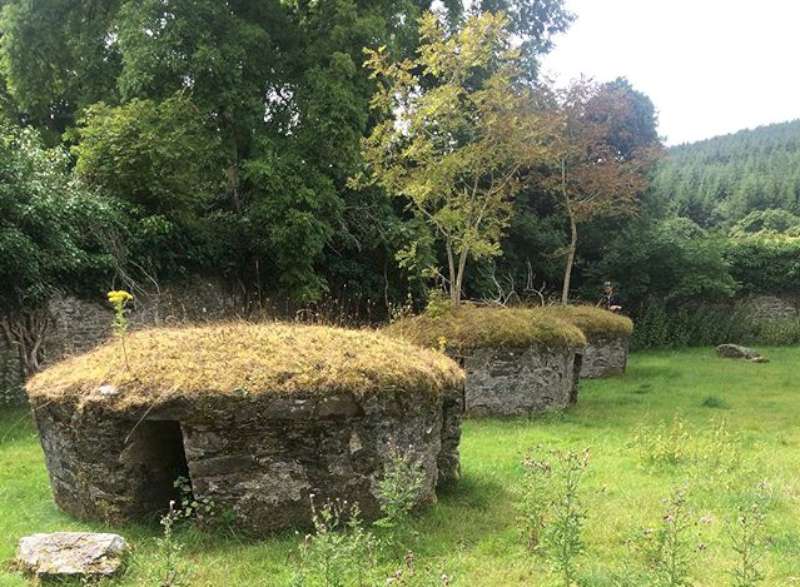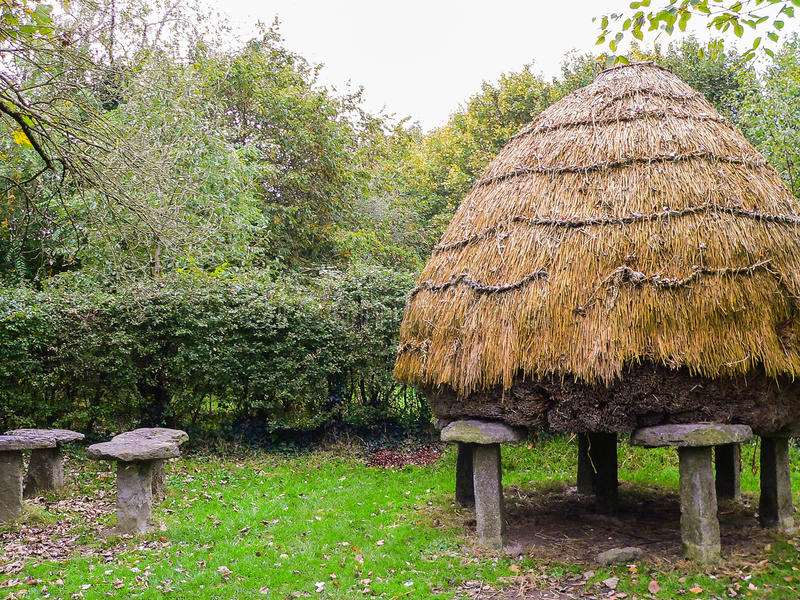Sarah has asked what were these structures in the walled garden at Mount Leader House used for? Does anyone have an idea?
============
============
We don’t think that they were houses for very little people!!
==================
Some ideas:
- For storing food in warm weather [Mary],
- for housing ducks and geese, with straw on top [Mary]
- ice houses [Alan, Eileen]
- for storing hay [Anne]
- for storing turf, and covered with a thatch like in the photo below [Michael]
- or the amusement and shelter of the foxhounds. The field was known as the Kennel Field [John O’M, John O’S, Michelle, Mick]
we are still searching for a definitive answer, and are keeping an open mind … any help would be appreciated!
==================
Similar structures at Bunratty Folk Park:
“Giving a speech on the famous stone situated near the stables at Coomlogane House c. 1920.” In her weekly newsletter, Eily Buckley mentioned that there was a photo of another one at Coomlogane House on page 18 of Picture Millstreet:
OSI Map of Mount leader from the late 1900’s where the field is marked out with “Kennels” [1]:
There are a number of comments on the cross-post for this article on facebook:
========
A better answer I found in 2024 by Liam Flynn:
“The three columns were used to store sheaves of corn for the winter. The columns are wider at the top than at the bottom. This prevented rodents from accessing the sheaves, which were trashed in the spring for that years seed. With a combination of the shape of the columns and the hounds rambling around the yard it was unlikely any rats would eat the sheaves.”



Could have been used in olden times to keep food cool in warm weather.
Could have been used in olden days for housing geese or ducks. Stack of u thrashed oats on top.
They were used to put hay stacks on to keep them dry.
Thanks Ann, I remember seeing something similar in Bunratty Folk Park last year. Though I thought they were used for storing reeds / straw for roofing material.

I asked a local man here & they were used as dog/hound kennels when it was an estate. The field is known as “The Kennel Field”
I’m sure that the walled field was used to hold the pack of Muskerry Hounds when they were in residence there from 1898 to 1906, and that the field got its name from that, but they would have been far from ideal housing for dogs.
Eily Buckley mentioned this morning in her newsletter that there is a photo of another similar one at Coomlogane House (photo added above). I suspect the structures they are much older than 1900 and had a different use than dogs.
“In 1898, the Muskerry Hunt pack was sold to Mr. H. W. Lender, of Forest, Coachford, that gentleman was elected by the members as master of the Hounds.
No better choice could have been made, as, in addition to being most popular in the district, the new master was a most capable huntsman; he had as his first whip and kennel huntsman,
J. Welch. Mr. Leader’s great difficulty was the scarcity of fox es, which had never been overcome since the reign of agrarian outrage. At the earnest desire of the district, he, although often tempted to resign, stuck to his post, all from his residence, Mount Leader, where he had his summer kennels, continued to support the Hunt in a most liberal manner. In winter, the hounds were moved to kennels at Forest.
In 1906, Mr. Leader sold his hounds to Mr. Thomas Donovan, of Fernhurst, Cork, who remained as Master for three years. During that time, Captain F. C. B. West hunted the hounds, and in 1909, upon the retirement of Mr. Donovan, he took over the Mastership, continuing to carry the horn himself, with J. Lynch as first whip and kennel huntsman.” – from the Muskerry Hunt in British Hunts and Huntsmen (1911)
I will do an article on H.W. Leader in a few days
when we were young my dad used to take us for walks up there as he worked there as a young man he told me they were for housing the dogs in bad weather
i don’t know for sure if he was telling us the truth LOL but we believed him at the time
They for for the hunting dogs.
There was also a long building for other animals
My first thought was “Dog Houses”. Then I see that my thought was not so original.